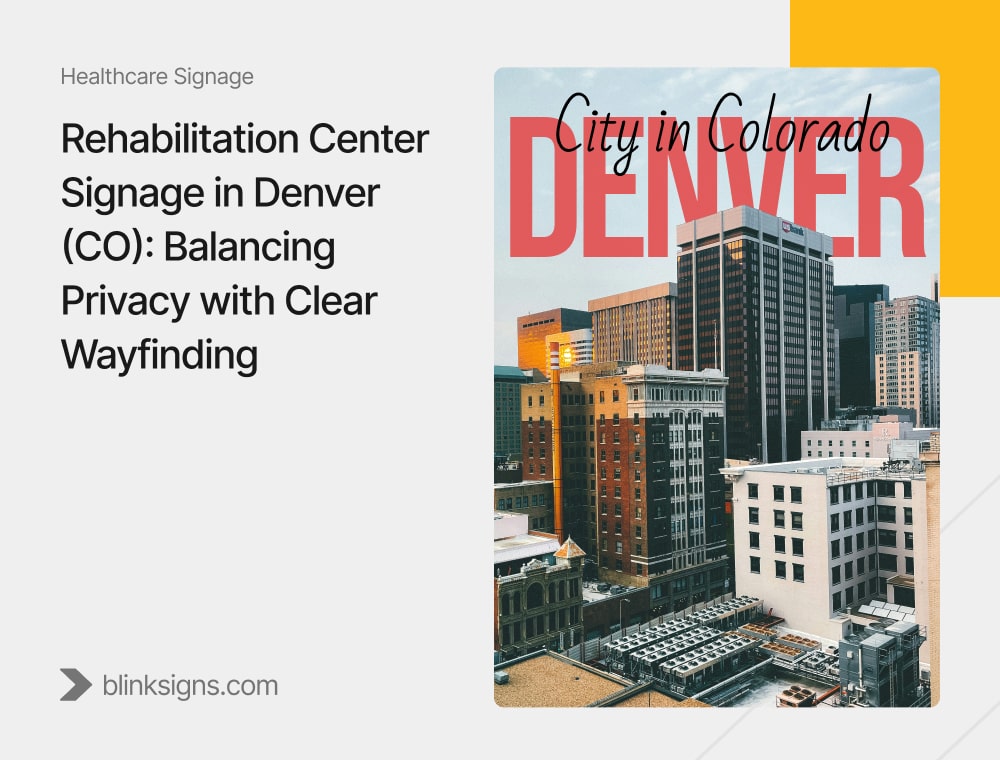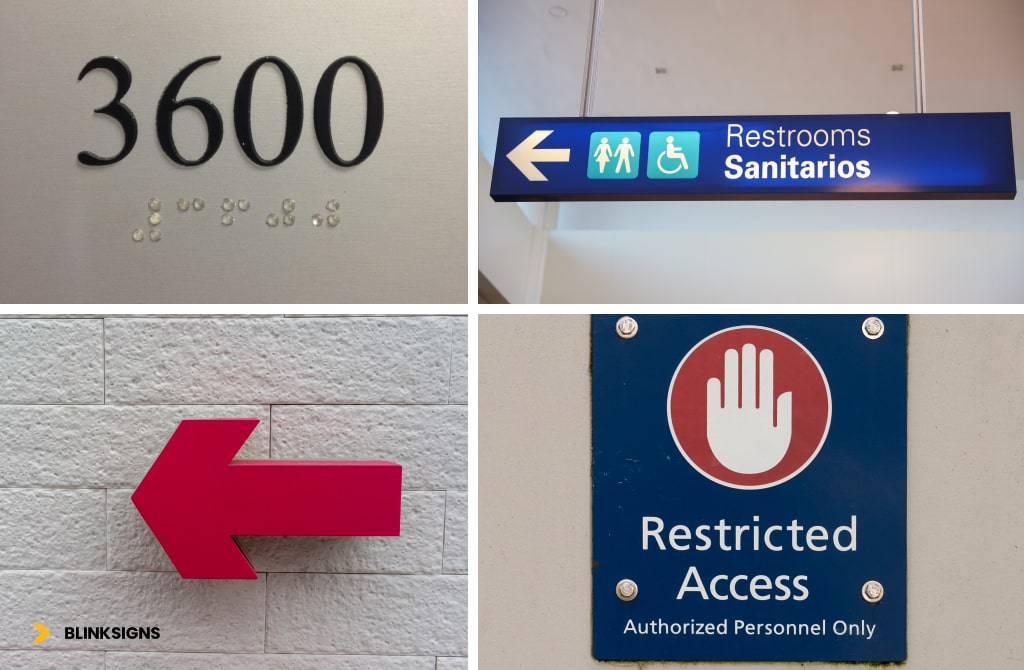
Rehabilitation Center Signage in Denver (CO): Balancing Privacy with Clear Wayfinding
Signage That Supports Recovery in Denver’s Healthcare Landscape
Denver’s rehabilitation centers, spanning physical therapy clinics, behavioral health hospitals, and addiction recovery programs, are designed to support healing. However, healing environments don’t begin in the treatment room; they start at the entrance, the hallway, and the check-in desk. This is where specialized rehab center signage becomes part of the care journey.
Unlike traditional medical signage, signage in rehab centers must balance emotional sensitivity with functional clarity. Patients often arrive vulnerable, seeking support while navigating a maze of corridors, therapies, and confidential services. In this context, signage must act as a silent guide: one that doesn’t overwhelm, doesn’t reveal, but always informs.
At BlinkSigns, we help rehabilitation facilities throughout Denver and the greater Front Range area design signage systems that are compliant, respectful, and intuitive. Whether it’s a discreet room plaque in a mental health unit or multilingual wayfinding for outpatient physical therapy, our systems are crafted to protect patient dignity while improving operational flow.
Designing for Privacy in Treatment-Focused Spaces

Designing for Privacy in Treatment-Focused Spaces
One of the most overlooked aspects of rehab center signage is privacy by design. Denver’s rehabilitation centers often serve patients dealing with trauma, mental health concerns, or addiction recovery, where privacy isn’t just a courtesy; it’s essential.
What Does Discreet Signage Look Like?
Discreet signage avoids loud typography, glaring placements, or callouts that reveal treatment purposes. Instead, it uses:
- Low-profile fonts
- Neutral tones
- Symbols over language when appropriate
- Room codes instead of therapy names for sensitive units (e.g., “Room 14” instead of “Substance Counseling”)
Signs for rooms such as counseling, group therapy, or detox must be visible only to those who need them, avoiding attention from casual passersby or non-clinical traffic.
BlinkSigns also supports the use of:
- Frosted vinyl panels and semi-transparent privacy graphics
- Non-illuminated identifiers for behavioral health wings
- HIPAA-compliant signage placement strategies for check-in desks and digital screens
Every sign should send a message: you’re safe, your journey is private, and you’re in the right place.
Wayfinding That Calms and Guides in High-Stress Environments

Wayfinding That Calms and Guides in High-Stress Environments
Even in the most modern rehabilitation centers, getting lost is common, especially for stressed new patients. Long hallways, overlapping departments, and unfamiliar clinical terms can overwhelm the most composed visitor.
Smart Wayfinding Solutions for Denver’s Rehab Facilities
BlinkSigns creates signage strategies that simplify patient, visitor, and staff movement. These include:
- Color-coded zones (e.g., blue for physical therapy, green for counseling services)
- Tactile and Braille signage on all doorways and directional signs
- Floor-based arrows and icons to reinforce directions visually
- Multilingual signs to accommodate Denver’s growing bilingual and immigrant populations
- ADA-compliant signage placement and height settings to ensure access for all mobility levels
We believe wayfinding should feel invisible. When done right, it reduces the need for patients to ask for help, decreases hallway congestion, and minimizes late arrivals, all while contributing to a calmer patient experience.
Safe Materials and Soothing Aesthetics for Healing Environments
Signage in rehabilitation settings must do more than guide, it must blend into the environment to promote emotional stability, hygiene, and patient safety. Even the sign material choices are critical in patient experience and safety compliance in behavioral health units or addiction recovery centers.
BlinkSigns uses hospital-grade, low-stimulation materials that are built for Denver’s medical environments. This includes:
- Anti-ligature mounting systems to reduce self-harm risks in mental health units
- Rounded corners and tamper-resistant screws to enhance physical safety
- Low-glare, wipeable acrylic and powder-coated metals to maintain cleanliness in high-traffic zones
- Biophilic tones and natural textures that align with trauma-informed design standards
Every sign is manufactured to serve a purpose: to guide gently, to clean easily, and to disappear when no longer needed. In spaces where healing is vulnerable and progress is personal, your signage must never disrupt the environment—it must enhance it.
Did You Know?
According to the Colorado Behavioral Health Administration, the Denver metro area has seen a 42% increase in licensed behavioral and substance recovery facilities since 2020. This growth reflects a post-pandemic shift toward decentralized, community-based care, and a rising need for signage that supports privacy and navigation in non-traditional clinical spaces.
How BlinkSigns Approaches Rehab Signage Challenges in Denver
| Challenge in Denver Rehab Centers | Recommended Signage Solution | Compliance Focus |
| Protecting patient privacy in therapy wings | Room identifiers with neutral naming + frosted privacy films | HIPAA, trauma-informed design |
| Managing complex layouts in outpatient rehab facilities | Color-coded zones, floor decals, and multilingual directionals | ADA, multilingual accessibility |
| Ensuring safety in behavioral health units | Anti-ligature signs, rounded corners, tamper-proof wall graphics | Colorado behavioral health safety standards |
| Guiding first-time patients through multi-service therapy clinics | Modular wayfinding systems with pictograms, Braille, and clear zone transitions | ADA, patient-experience optimization |
| Retrofitting older Denver clinics to meet signage codes | Wipeable, antimicrobial signage packages + compliant mounting upgrades | CDPHE, Denver sign code |
How Signage Supports Trauma-Informed Design in Rehab Facilities
Rehabilitation centers that serve patients recovering from addiction, trauma, or mental health crises are increasingly adopting trauma-informed design principles, and signage plays a role in that shift.
Thoughtful signage design helps create environments where patients feel safe, respected, and empowered. Key elements include:
- Soft, non-reflective surfaces that avoid visual overstimulation
- Simple iconography and neutral language to reduce emotional triggers
- Minimized staff dependency, where signage allows patients to find rooms or services without asking for directions
- Color psychology, using calming tones to reinforce a sense of security and control

Signage Design Considerations for Rehab Facilities
BlinkSigns incorporates these principles into signage recommendations for behavioral and mental health environments, ensuring the sign directs and heals.
BlinkSigns: Full-Service Signage Solutions for Denver’s Rehab Sector
Denver’s healthcare network is growing rapidly, especially in the fields of mental health, physical therapy, and substance abuse recovery. At BlinkSigns, we provide signage systems specifically designed for this industry, and this region.
Our services for rehabilitation centers in Denver include:
- Patient-centered wayfinding strategy development
- ADA and HIPAA signage audits for existing facilities
- Fabrication using behavioral health-safe materials
- Sign permitting support through Denver’s planning department.
- On-site installation during low-traffic hours
- Discreet signage solutions for trauma-sensitive care settings
We help rehab centers maintain privacy and dignity while achieving operational efficiency, brand consistency, and city-wide compliance.
Frequently Asked Questions (FAQs)
What types of signage help protect patient privacy in a rehab center?
Neutral room labels, minimalistic directionals, and HIPAA-sensitive placements are best for protecting patient identities and treatment types.
Can signs be made both transparent and discreet?
Yes. BlinkSigns uses icons, room codes, soft typography, and intentional placement to provide clarity without calling attention to sensitive areas.
What are the signage rules for healthcare centers in Denver?
Denver requires compliance with the city sign code, ADA rules, and CDPHE standards. We handle permitting and ensure your facility follows all regulations.
How do you make signage safe for behavioral health units?
We use tamper-resistant, anti-ligature materials with soft corners, no exposed fasteners, and calming colors to meet safety and design needs.
Can BlinkSigns retrofit our existing rehab signage to meet modern standards?
Absolutely. We offer complete signage audits and retrofitting services for clinics needing ADA, HIPAA, or Denver code compliance updates.
Help Patients Heal Without Getting Lost
In Denver’s rehabilitation centers, adequate signage is more than functional, it’s part of the care experience. BlinkSigns delivers privacy-minded, ADA-compliant, and emotionally intelligent signage systems that support healing, dignity, and safety.
Request a Custom Rehab Signage Consultation →
Proudly serving physical therapy clinics, addiction recovery centers, and behavioral health providers across Denver, Aurora, and the Front Range corridor.